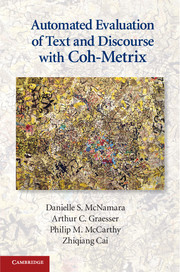Book contents
- Frontmatter
- Dedication
- Contents
- List of Figures
- List of Tables
- Acknowledgments
- Introduction
- Part I Coh-Metrix
- Part II A Beginner’s Guide to Writing Coh-Metrix Research
- 7 The Strategy
- 8 The Introduction
- 9 The Corpus
- 10 The Tool
- 11 The Results
- 12 The Discussion
- Concluding Remarks
- References
- Appendix A Coh-Metrix 3.0 Indices
- Appendix B Coh-Metrix Indices Norms
- Index
8 - The Introduction
Published online by Cambridge University Press: 05 June 2014
- Frontmatter
- Dedication
- Contents
- List of Figures
- List of Tables
- Acknowledgments
- Introduction
- Part I Coh-Metrix
- Part II A Beginner’s Guide to Writing Coh-Metrix Research
- 7 The Strategy
- 8 The Introduction
- 9 The Corpus
- 10 The Tool
- 11 The Results
- 12 The Discussion
- Concluding Remarks
- References
- Appendix A Coh-Metrix 3.0 Indices
- Appendix B Coh-Metrix Indices Norms
- Index
Summary
Writing the introduction section of a research paper can be a terribly frustrating affair. It seems that of any major section of a paper, none require more reediting, reorganizing, and resubmitting than the introduction. In this chapter, we hope to somewhat alleviate that aspect of the research paper writing process by describing and discussing the next six major moves of the Elevator Pitch. To be sure, even with each of these six moves tackled and pinned, writing the introduction is still likely to require a substantial amount of work, but having the Elevator Pitch to work from should at least provide reference points to guide you as to which parts of your paper need your attention most.
One of the major reasons for the introduction needing so much reworking is that the research project seldom adheres rigidly to the plan. That is, no matter how well you plan a project, the results are unlikely to fall neatly into the baskets that you might have hoped for. And let’s face it, if the results of the project really did end up completely as predicted then chances are your experiment wasn’t really all that interesting to begin with. Of course, you might just think that if a plan is truly well thought out, then such problems are unlikely to be overly arduous. However, there is a good reason why our language is replete with expressions such as “the best laid plans of mice of men” and “the first casualty of war is the plan”: Expressions such as these remind us that while we should carefully plan for the best, we should always be ready to expect the worst. Consequently, if we rely on merely our project’s plan, and write too much of the introduction before we have fully examined the data, then we will often end up with a beautiful but unusable introduction. Such an introduction inevitably faces shredding, and it is this shredding that can lead to the frustration that is all too familiar with writing the introduction section of the research paper.
- Type
- Chapter
- Information
- Automated Evaluation of Text and Discourse with Coh-Metrix , pp. 128 - 144Publisher: Cambridge University PressPrint publication year: 2014



